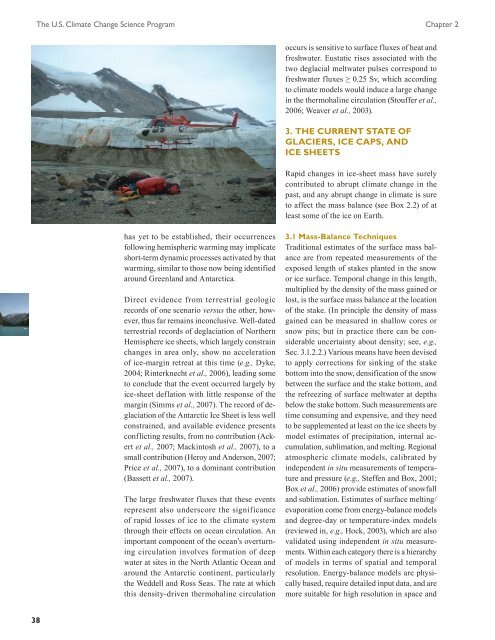Book 2.indb - US Climate Change Science Program
Book 2.indb - US Climate Change Science Program
Book 2.indb - US Climate Change Science Program
- No tags were found...
You also want an ePaper? Increase the reach of your titles
YUMPU automatically turns print PDFs into web optimized ePapers that Google loves.
The U.S. <strong>Climate</strong> <strong>Change</strong> <strong>Science</strong> <strong>Program</strong> Chapter 2occurs is sensitive to surface fluxes of heat andfreshwater. Eustatic rises associated with thetwo deglacial meltwater pulses correspond tofreshwater fluxes ≥ 0.25 Sv, which accordingto climate models would induce a large changein the thermohaline circulation (Stouffer et al.,2006; Weaver et al., 2003).3. The current state ofglaciers, ice caps, andice sheetsRapid changes in ice-sheet mass have surelycontributed to abrupt climate change in thepast, and any abrupt change in climate is sureto affect the mass balance (see Box 2.2) of atleast some of the ice on Earth.has yet to be established, their occurrencesfollowing hemispheric warming may implicateshort-term dynamic processes activated by thatwarming, similar to those now being identifiedaround Greenland and Antarctica.Direct evidence from terrestrial geologicrecords of one scenario versus the other, however,thus far remains inconclusive. Well-datedterrestrial records of deglaciation of NorthernHemisphere ice sheets, which largely constrainchanges in area only, show no accelerationof ice-margin retreat at this time (e.g., Dyke,2004; Rinterknecht et al., 2006), leading someto conclude that the event occurred largely byice-sheet deflation with little response of themargin (Simms et al., 2007). The record of deglaciationof the Antarctic Ice Sheet is less wellconstrained, and available evidence presentsconflicting results, from no contribution (Ackertet al., 2007; Mackintosh et al., 2007), to asmall contribution (Heroy and Anderson, 2007;Price et al., 2007), to a dominant contribution(Bassett et al., 2007).The large freshwater fluxes that these eventsrepresent also underscore the significanceof rapid losses of ice to the climate systemthrough their effects on ocean circulation. Animportant component of the ocean’s overturningcirculation involves formation of deepwater at sites in the North Atlantic Ocean andaround the Antarctic continent, particularlythe Weddell and Ross Seas. The rate at whichthis density-driven thermohaline circulation3.1 Mass-Balance TechniquesTraditional estimates of the surface mass balanceare from repeated measurements of theexposed length of stakes planted in the snowor ice surface. Temporal change in this length,multiplied by the density of the mass gained orlost, is the surface mass balance at the locationof the stake. (In principle the density of massgained can be measured in shallow cores orsnow pits; but in practice there can be considerableuncertainty about density; see, e.g.,Sec. 3.1.2.2.) Various means have been devisedto apply corrections for sinking of the stakebottom into the snow, densification of the snowbetween the surface and the stake bottom, andthe refreezing of surface meltwater at depthsbelow the stake bottom. Such measurements aretime consuming and expensive, and they needto be supplemented at least on the ice sheets bymodel estimates of precipitation, internal accumulation,sublimation, and melting. Regionalatmospheric climate models, calibrated byindependent in situ measurements of temperatureand pressure (e.g., Steffen and Box, 2001;Box et al., 2006) provide estimates of snowfalland sublimation. Estimates of surface melting/evaporation come from energy-balance modelsand degree-day or temperature-index models(reviewed in, e.g., Hock, 2003), which are alsovalidated using independent in situ measurements.Within each category there is a hierarchyof models in terms of spatial and temporalresolution. Energy-balance models are physicallybased, require detailed input data, and aremore suitable for high resolution in space and38






